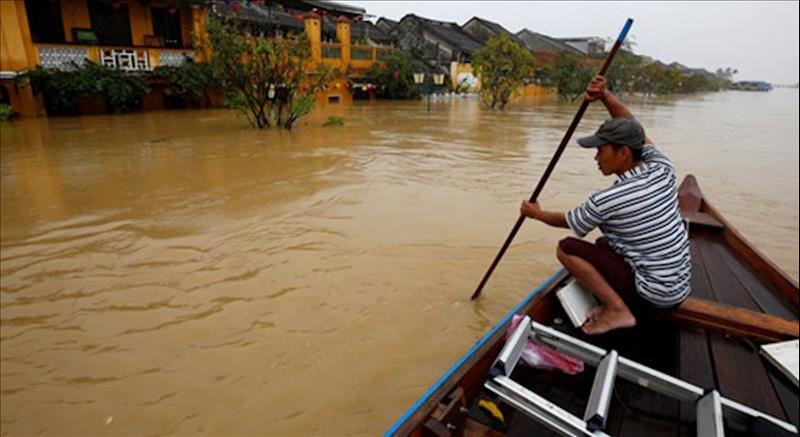
At COP26, Vietnam must stress peril of rising sea levels
(MENAFN- Asia Times) In a recent speech at the UN Security Council, Ambassador Dang Dinh Quy, permanent representative of Vietnam, reminded member nations that rising sea levels are a major threat for coastal nations, especially in the lowlands of China, Bangladesh, Indonesian islands, Philippine archipelagos and Vietnam.
Other delegates lauded Quy's initiative, since it signaled Vietnam's preparation for next month's pivotal climate change summit in Glasgow, called COP26, that is expected to set the course of climate action for the next decade.
The science on rising sea levels cannot be ignored in Asia. Millions of people live along coastal waters.
For Vietnam, the Mekong River Delta is a vast spread of fertile riverbeds, islets and mangrove swamps at the end of the Mekong River. It is now among the most vulnerable regions in southern Vietnam.
The delta is home to more than 20 million people, who produce almost half of the country's rice harvest. A million hectares of land is regularly affected by flooding due to ocean tides. Crops and people's livelihoods are at stake.
Vietnamese President Nguyen Xuan Phuc has frequently warned that climate change threatens world security. In an earlier speech at the UN, he sought improved implementation of the UN Charter in international relations and climate adaptation . Vietnam plans to borrow around US$2 billion to fortify the Mekong Delta with sustainable development in the face of climate change.
There is international agreement that rising sea levels must be considered a challenge to international peace and security. The US National Security Council and the Pentagon have warned that climate change will result in food shortages in some countries that could lead to unrest, along with skirmishes over water.
The most recent report from the United Nations' Intergovernmental Panel on Climate Change (IPCC), prepared by more than 100 scientists from more than 80 countries, describes a worrying scenario. Their evidence confirms that even if there are drastic cuts in carbon emissions, nations like Vietnam will be impacted by high tides.
Over the past five decades, Vietnamese farmers have seen sea levels rise by about 20 centimeters. Also, climate change has made natural disasters, especially typhoons, floods, and droughts, more severe. In short, global mean sea levels will most likely rise between 30 and 110 centimeters by the end of this century.
Ho Chi Minh City, home to more than 9 million people including migrants, continues to experience regular flooding due to increased storms, intense rainfall, and upstream discharges. Of the city's 322 communes and wards, about half have a history of regular flooding, with 40-50% of land in the city less than a meter above sea level.
What's clear is that rising sea levels amplify storm surges and bring in additional chronic threats of tidal flooding. Riverine flooding becomes even more severe with increases in heavy precipitation.
The World Economic Forum has described Vietnam's economy as a“miracle of growth,” since it has expanded 6-7% a year over the past decade. However, during the Covid-19 pandemic, Vietnam's gross domestic product dropped 6.17% on the year for the July-September period, as draconian lockdowns in key areas, including Ho Chi Minh City, led to the first decline since 2000 on a quarterly basis.
A McKinsey report details how the vibrant metropolis' annual flooding can be compared to a tax on the economy. According to its modeling, and use of flood maps, the impacts may amount to about $1.3 billion a year, predominantly from real-estate damage. This represents about 2% of the city's GDP.
Although the city has survived recurrent floods, it is anticipated that the costs due to regular flooding will continue to rise – and faster than economic activity.
Rapid expansion has left the city vulnerable to climate change, with an increase in flood levels over the past decade. Overdevelopment and the sheer weight of infrastructure in some districts have caused the soft soil of the city to subside. Hydrologists claim that HCMC is now sinking at a rate of 1-2cm every year, while sea levels rise at the same time.
Experts believe that Ho Chi Minh City should expect significant disruptions each year. While real-estate damage is still the largest cost, infrastructure assets such as on the city's metro, now under construction, may experience further delays associated with intense storms and flooding.
Despite government pledges to spend in excess of $345 million on anti-flood projects, the predicted sea-level rise and intense storm surges will require multilateral support, and breakthroughs on adaptation and resilience.
Climate change remains a huge barrier to sustainable development. It also has the potential to affect millions of people around the globe through the loss of livelihoods, infrastructure, and homes, displacement, and an increased risk of statelessness.
During the upcoming climate-change summit, Vietnam must stress the need to save the Mekong Delta from further devastation.

Legal Disclaimer:
MENAFN provides the information “as is” without warranty of any kind. We do not accept any responsibility or liability for the accuracy, content, images, videos, licenses, completeness, legality, or reliability of the information contained in this article. If you have any complaints or copyright issues related to this article, kindly contact the provider above.






















Comments
No comment